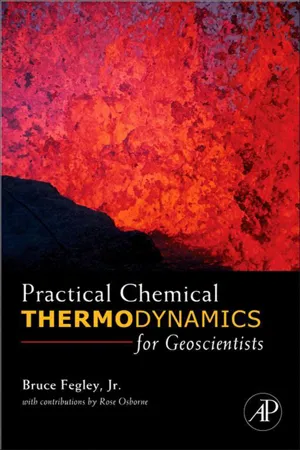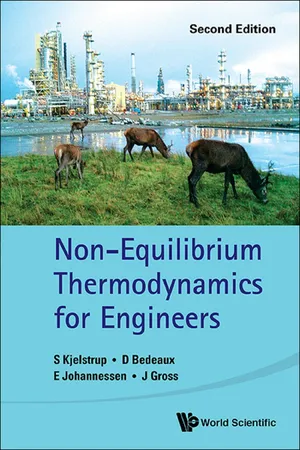Technology & Engineering
Free Expansion of an Ideal Gas
The free expansion of an ideal gas refers to a process in thermodynamics where a gas expands into a vacuum without performing work or exchanging heat with its surroundings. During free expansion, the gas experiences a rapid and irreversible expansion, leading to a decrease in temperature and no change in internal energy. This process is often used as an example to illustrate the concept of irreversible processes in thermodynamics.
Written by Perlego with AI-assistance
Related key terms
Related key terms
1 of 4
Related key terms
1 of 3
3 Key excerpts on "Free Expansion of an Ideal Gas"
- Bruce Fegley Jr.(Author)
- 2012(Publication Date)
- Academic Press(Publisher)
internal pressure and it represents the internal cohesive (or attractive) forces in a gas, liquid, or solid. In 1843, Joule evaluated this term for gases in another classic experiment.L Joule’s free expansion experiment
Figure 3-6 schematically illustrates Joule’s experiment. Container A holds dry air at 22 atmospheres that is allowed to expand into the evacuated container B when stopcock D is opened. The whole apparatus is submerged in a water bath. The bath is stirred and its temperature is measured before and after the gas expansion. Joule found that “no change of temperature occurs when air is allowed to expand in such a manner as not to develop mechanical power” (i.e., when no work is done). From the first law,(3-11)FIGURE 3-6 A schematic diagram of Joule’s free expansion experiment. Air under pressure in cylinder A expands into evacuated cylinder B when valve D is opened. The apparatus is submerged in a water bath. The water is stirred and its temperature measured before and after the expansion.Joule observed no change in the temperature of the water bath, so the gas did not gain or lose heat (δq = 0). The gas freely expanded into a vacuum, so the applied pressurePap= 0, and no work was done (δw =Pap dV= 0). Thus, from Eq. (3-11) , the change in internal energy (dE ) was also zero. As a result, Eq. (3-46) can be set equal to zero:(3-50)Equation (3-50) can be evaluated easily because the isothermal conditions mean dT = 0, but the expansion means that dV was positive. Hence, the only way for the first term to be zero is that(3-51)Joule and Kelvin subsequently showed that Eq. (3-51) is only valid for ideal gases. Their work is discussed in Chapter 8 . For now, the key point is that an ideal gas obeys Eq. (3-51) .III Some Applications of the First Law to Ideal Gases
This section describes some applications of the first law to a number of thermodynamic processes in which one or another variable is held constant. We then have to decide how to calculate the changes (if any) in internal energy, work, heat, enthalpy, temperature, pressure, or volume that take place in the different types of processes. We start with the difference in constant-pressure and constant-volume heat capacities because this information is needed to do calculations for isothermal, isochoric, and adiabatic processes.- eBook - ePub
Statistical Thermodynamics
An Information Theory Approach
- Christopher Aubin(Author)
- 2024(Publication Date)
- Wiley(Publisher)
There are two methods for doing so that we can understand with the tools at our disposal. 7.2.1 Free Expansion Let’s consider the following setup, as shown in Figure 7.2 (a): We have a gas in equilibrium at some volume (the left side of the container in the figure) with a temperature, and the entire system (including the right side of the container) is thermally isolated from its surroundings. We then open a valve and the gas is allowed to move to the right side of the container (Figure 7.2 (b)) such that eventually it fills the entire volume (Figure 7.2 (c)). This process, known as free expansion, will bring the system to a temperature which we will show is not greater than. As the system is thermally isolated, this is an adiabatic process, and thus. Additionally, the gas does no work (there is nothing for the gas to do work on in the right half of the container), so. By the first law, the energy remains constant in this process, or (7.13) which is true even if this is not a quasistatic process. If the point of this procedure were to cool the gas, this would be a bad approach if the gas were ideal because we know the energy is independent of the volume, so Figure 7.2 Free expansion of a system at three stages: (a) the gas is contained in a volume and is thermally isolated, (b) then a valve is opened to allow the gas to move to the right side, and (c) finally the gas is in equilibrium in some new volume. Figure 7.3 The molar energy vs. the temperature for three different volumes of nitrogen, treating it as a Van der Waals gas. The horizontal line shows the constant energy line to determine the change in temperature given a change in volume for a free expansion of the gas. Of course for a real system, this cannot be completely thermally isolated; the container will have a non‐negligible heat capacity, but that will not have a significant effect on this result. For a Van der Waals gas with constant specific heat, we know the molar energy difference, from Eq - eBook - ePub
- Signe Kjelstrup, Dick Bedeaux;Eivind Johannessen;Joachim Gross;(Authors)
- 2017(Publication Date)
- WSPC(Publisher)
149 ].We start by explaining the isothermal expansion of an ideal gas, so we can give some exact results. We find the work, the ideal work, the lost work, the entropy production and the minimum entropy production, given certain constraints. We then introduce optimal control theory and explain how this mathematical framework can be used to find the state of minimum entropy production, using the isothermal expansion as an example. We find that the local entropy production is constant throughout the optimal expansion process. This is an example of the theorem of equipartition of entropy production (EoEP) [136 , 150 , 151 , 152 , 153 , 154 ]. It says that the entropy production should be constant throughout the process.11.1 Isothermal expansion of an ideal gasA schematic picture of a container filled with an ideal gas is given in Fig. 11.1 . The container is equipped with a piston so that work can be extracted by expanding the gas. Heat is transferred to the gas from the surroundings in order to keep the temperature constant. The temperature of the surroundings and the system is T0 (reversible heat transfer). We consider the expansion of the gas from an initial pressure p1 to a final pressure p2 . The corresponding volumes are V1 and V2 , respectively. Elementary textbooks are mainly dealing with the reversible version of the process. Only simple irreversible examples, without any constraint on the process duration, are discussed (see for instance [155 ]). For such simple processes, a complete thermodynamic treatment is possible without introducing any details about time and the dynamics of the process.Most processes, both in nature and in industry, proceed in a finite period of time, however. We fix the duration of the expansion, Θ, and assume that the movement of the piston can be described by the differential equations
Index pages curate the most relevant extracts from our library of academic textbooks. They’ve been created using an in-house natural language model (NLM), each adding context and meaning to key research topics.
Explore more topic indexes
Explore more topic indexes
1 of 6
Explore more topic indexes
1 of 4


